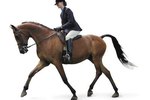
Every piece of equipment matters in a sport where a fraction of a second can make the difference between walking away with a new saddle and an envelope full of prize money versus walking away empty handed. Barrel racing is a high performance equine sport, and choosing the right bit for your horse can make a big difference in how well you communicate with him when you are in the arena.
Your Bit's Job
A bit is more than a piece of metal that you stick in your horse's mouth. The shape, weight and even material the bit is made of can make a difference in how well your barrel horse runs for you during competition. You want a bit that encourages your horse to move forward and respond to the lightest of cues while still delivering enough stopping power to prevent your horse from exiting the arena like a train with failing brakes. There is no one right or wrong choice of bit, though some versions are more popular than others. Your horse's abilities and training level, as well as your own riding ability, will have a substantial role in helping you choose the right bit to compete with. If you're having a hard time selecting a bit for your horse, you will want to try a number of different bits, and use trial and error to figure out what works best for your horse.
Snaffle
A simple snaffle bit almost always is a good choice for any type of riding discipline, including barrel racing. When you are in the process of figuring out what type of bit you want to use, start off with a snaffle and make changes from there. A snaffle bit is relatively gentle, especially compared to some of the more sophisticated and specialized bits. It is unlikely to cause any performance problems for your horse, and if your horse runs well in a bit that features a basic snaffle design, then he likely has a sensitive mouth and will not benefit from a harsher bit.
Shanked Bits
Most barrel racers run in some type of shanked, curved bit. The severity of these bits can range from relatively mild to quite severe, depending on their design features. The shorter the shank of the bit, the less leverage (stopping power) you have. The mouthpiece on a shanked bit can be almost anything you want it to be; hundreds of different options are available from various tack stores and manufacturers. If you are going to use a shanked bit, the mouthpiece must be well balanced as well as providing your horse with enough support to encourage him to bend well without falling in during the turns. You do not want a bit that is harsher than your horse needs, because he will get too used to it and can become unresponsive to more subtle cues. Most shanked bits also include a curb strap. Some shanked bits have a gag action as well, but running in a gag bit during competition has somewhat fallen out of favor. Gag bits are considered to be fairly harsh and can do a lot of damage to the mouth when being ridden by a hard-handed or unbalanced rider.
Hackamores
Hackamores are bitless bridles and work without putting anything at all actually inside your horse's mouth. They should be used on horses who work well when rider cues come from pressure on the face and poll rather than the mouth. These can be very useful with a horse who dislikes a bit or who has a hardened mouth due to previous bad riding. Note that most barrel racers use what is called a mechanical hackamore, rather than a gentler bosal or sidepull. Mechanical hackamores are made mostly of metal, tough rope and wire. They can exert a lot of pressure on your horse's nose when you engage the leverage and, in unskilled hands or on a green horse, have the potential to break the cartilage in the nose and cause serious damage to the horse. Mechanical hackamores can be used safely by experienced riders, but an inexperienced or heavy handed rider can be downright dangerous when using one.
References
Photo Credits
-
David Greedy/Getty Images News/Getty Images
Writer Bio
Jen Davis has been writing since 2004. She has served as a newspaper reporter and her freelance articles have appeared in magazines such as "Horses Incorporated," "The Paisley Pony" and "Alabama Living." Davis earned her Bachelor of Arts in communication with a concentration in journalism from Berry College in Rome, Ga.




